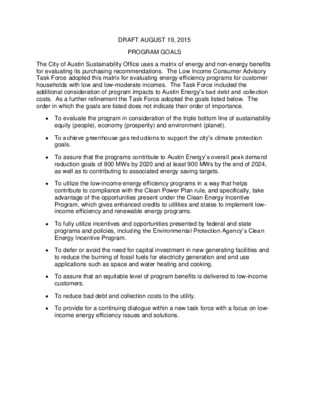Item 3c-Weatherization Program Goals_Carol Biedrzycki — original pdf
Backup

DRAFT AUGUST 19, 2015 PROGRAM GOALS The City of Austin Sustainability Office uses a matrix of energy and non-energy benefits for evaluating its purchasing recommendations. The Low Income Consumer Advisory Task Force adopted this matrix for evaluating energy efficiency programs for customer households with low and low-moderate incomes. The Task Force included the additional consideration of program impacts to Austin Energy’s bad debt and collection costs. As a further refinement the Task Force adopted the goals listed below. The order in which the goals are listed does not indicate their order of importance. To evaluate the program in consideration of the triple bottom line of sustainability equity (people), economy (prosperity) and environment (planet). To achieve greenhouse gas reductions to support the city’s climate protection goals. To assure that the programs contribute to Austin Energy’s overall peak demand reduction goals of 800 MWs by 2020 and at least 900 MWs by the end of 2024, as well as to contributing to associated energy saving targets. To utilize the low-income energy efficiency programs in a way that helps contribute to compliance with the Clean Power Plan rule, and specifically, take advantage of the opportunities present under the Clean Energy Incentive Program, which gives enhanced credits to utilities and states to implement low-income efficiency and renewable energy programs. To fully utilize incentives and opportunities presented by federal and state programs and policies, including the Environmental Protection Agency’s Clean Energy Incentive Program. To defer or avoid the need for capital investment in new generating facilities and to reduce the burning of fossil fuels for electricity generation and end use applications such as space and water heating and cooking. To assure that an equitable level of program benefits is delivered to low-income customers. To reduce bad debt and collection costs to the utility. To provide for a continuing dialogue within a new task force with a focus on low-income energy efficiency issues and solutions. LOW-INCOME WEATHERIZATION PROGRAM GOALS In light of the public disagreement over the value of the now completed ARRA program the Task Force recommends that the utility move forward with a program designed to meet specific goals and to evaluate the program in accordance with those goals. In addition to and in accordance with the program goals presented earlier the Task Force adopted the following goals for the low-income weatherization program. To reduce the energy burden and energy costs for low‐income families, particularly for the elderly, people with disabilities and, families with children, by improving the energy efficiency of their homes. To assess the energy efficiency needs of individual dwelling units in a holistic manner to identify appropriate energy efficiency measures. To provide the program at no out of pocket cost to eligible customers. To improve the healthfulness, safety, and affordability of housing. To leverage utility and other available program resources to offer seamless home repair and weatherization services. To collaborate and partner with local organizations and educational institutions that train and hire residents from disadvantaged communities and increase economic investment in those communities. To assure that the customers’ long term needs are met for refrigeration, lighting, cooling, and heating. To ensure that the measures installed under the program have a useful life that is greater than the amount of time a customer has to wait to requalify for the program (currently 10 years). To lower overall program costs including administrative, materials and equipment, labor, quality control, etc. to the maximum extent possible. To partner with community organizations and other city departments to deliver programs efficiently and effectively and to educate residents about energy efficiency. To explore and maximize opportunities for program expansion such as neighborhood by neighborhood programs that would reduce administrative costs. To provide the oversight necessary to assure that the quality of materials and equipment provided under the program and their installation meet equal or better standards than those standards applied to other residential programs.